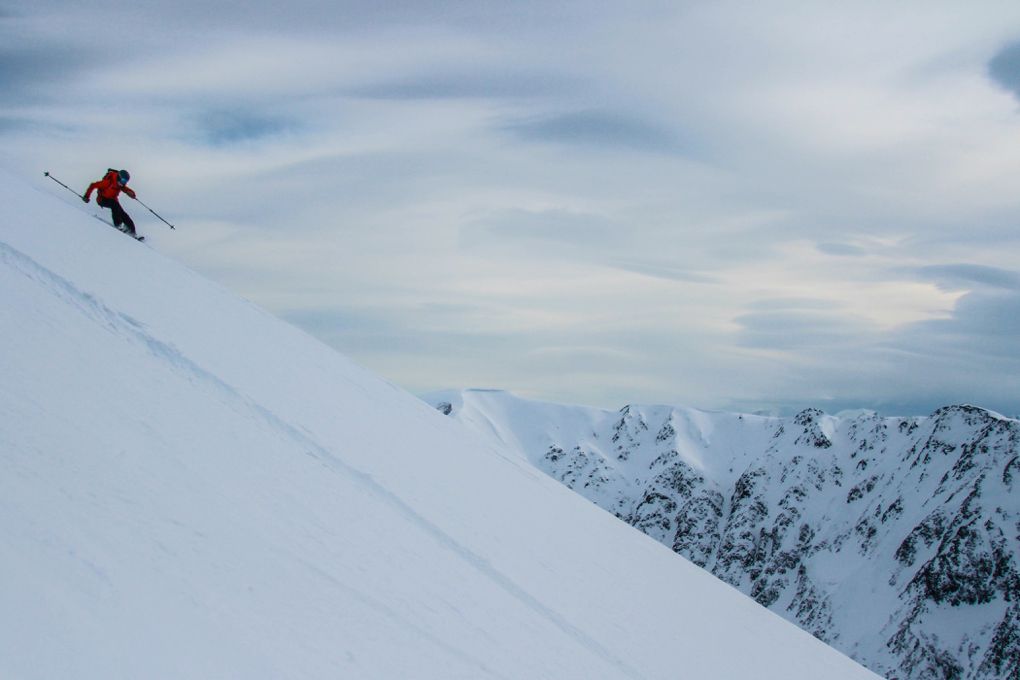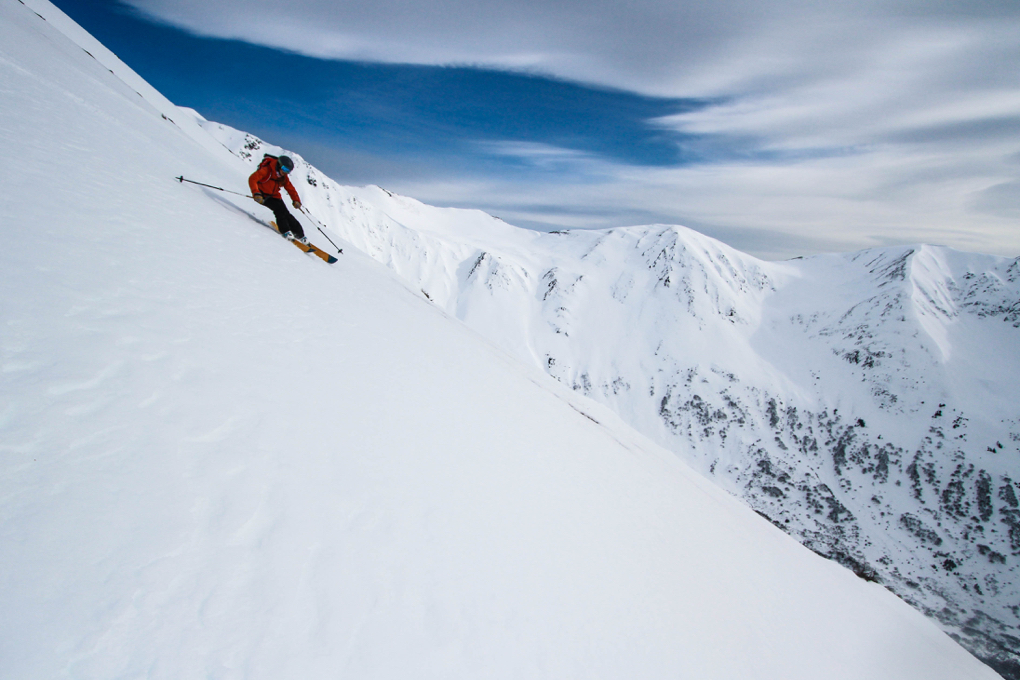Spring Pow
I’ve spent the past two weeks touring around Girdwood, Alaska on the Wailer 112RP2 Tour1. Like a lot of places in the United States, Girdwood is coming off of a mild winter that didn’t bring much snowfall, although it’s still been possible to find great snow up high.
It’s been very warm on a lot of days I’ve been out, and on some aspects, the snow has been a bit heavier and more consolidated. On my first run down a gorgeous, west-facing bowl, I started out with some large, sweeping turns across the face. The snow was a little more condensed, providing some resistance, but the Wailer 112RP2 Tour1 felt smooth and stable at medium speeds. It planed nicely across the surface of the snow, providing a wide, surfy platform that smoothed out some of the soft inconsistencies in the snow.

I don’t usually ski full speed when I’m in the backcountry since it would be a big bummer to crash and get hurt, so I never brought the ski up to my top speed. I was able to open it up a bit though on the second lap after getting a feel for the snow and the skis. Since the sun was baking the snow, there was a small bit of a crust forming on the surface, which I could feel grabbing the ski’s edges a bit. I think this may have been slightly more pronounced than if I had been on a heavier ski, since the Wailer 112RP2 Tour1 felt more prone to being knocked around. Further down, once there was even more of a crust, it took a little more effort to make hop turns through the crust, rather than having the power to plow through it.
On another day, we skied out to a peak with a beautiful ramp down the north face, where the snow was a little less sun-affected. Here, the snow was a little buffed out, but soft and shaded, with a steep entrance. The Wailer 112RP2 Tour1 felt smooth arcing big turns down the fall line, and I didn’t experience any strange behavior. The ski stayed on the surface nicely and the extra width gave it a playful, fun feel.
In all of the soft snow conditions I encountered on the Wailer 112RP2 Tour1, I had an absolute blast.
Frozen Crud
Although we were able to find great snow in the alpine, we had a few days where we encountered challenging conditions below treeline. Even though it was warm, the snow never really softened, it had recently rained and then refroze, and was tracked out in some areas. Navigating this snow and terrain was actually quite terrifying, and I had to ski slowly and carefully.
The snow was inconsistent, bumpy, and slick, and the light weight of the ski felt pretty unpredictable. If I did start to go fast at all, I would inevitably end up hitting a small chunk or bump and get bucked or thrown down, or one ski would catch a little groove and send me off in another direction. Basically, I just needed a lot of room on either side of whatever path I chose to ski in case I got caught and sent off in a different direction. My partner was skiing on the 13/14 Blizzard Dakota—a heavier ski with metal—and I would have been much more excited to be on the Dakota in such firm, challenging conditions. Having said that, even on the Dakota, she wasn’t having a great time with the snow, either.
I was able to make it down by doing long, horizontal sliding, but it was a pretty unenjoyable experience. I can’t say that I was too surprised—this is a very lightweight ski—but I did find that the skis were hard to control on firmer snow. It’s something to consider if you encounter these conditions often during approaches or coming out of higher alpine zones.
On the flip side, in tighter sections where I needed to turn quickly, the ski is light and very conducive to making fast hop turns.
Wind Scoured Faces
We got to spend some time on some alpine faces that were quite wind affected, and a lot of snow had been blown off. This left firm but smooth snow underneath. The Wailer 112RP2 Tour1 did alright here; it’s not as confidence inspiring on firmer snow, but having a more consistence surface allowed me to link turns and feel like I could hold an edge on some of the more exposed faces.
With more speed, I felt a bit of the ski’s shakiness and some chatter in the tips, but overall, felt comfortable making strong, controlled turns down steeper terrain on firm snow.

The Wailer 112RP2 does not excel when the snow firms up, but similar to the majority of other lightweight skis I’ve been on, I was not expecting it to. In the time I’ve spent in the backcountry, it’s not uncommon for me to find myself in high alpine terrain, where there can be plenty of variable snow conditions. Even though I have been impressed by the ski’s stiffness and ability to get up on edge, its low weight just does not make it a fun ski in hard, cruddy snow.
That is the tradeoff, though, for getting to enjoy an effortless skin going up, and it skis great in softer snow.
If you spend more of your time seeking out steep, challenging lines that are icy and firm, you’ll probably want something with a little more dampness and power. But if you don’t plan on skiing those conditions too often in the backcountry, or want a lighter ski that excels in soft snow, the Wailer 112RP2 Tour1 is an excellent option.
Softer Variable
After the short high-pressure system that left us with such firm conditions below treeline, a multi-day storm system deposited several feet of snow up high and a foot or so down low, softening things up quite a bit. I got to ski the same section of trees and rollers that I had found so terrifying the week before, but with much softer snow, even slush in some places. The Wailer 112RP2 Tour1 skied so much better here, and I could make fast turns around the bumps, with quick direction changes. While I still didn’t feel totally comfortable going as fast as my partner since the skis still were somewhat unpredictable, skiing the same terrain with slightly softer snow made a world of difference, and didn’t feel jarring at all.
Bottom Line
The DPS Wailer 112RP2 Tour1 has been a lot of fun in any of the conditions I encountered where the snow was soft, but didn’t (unsurprisingly) perform quite as well in firm snow. But their low weight makes them fantastic for touring.
I think that this comes down to what you value in a backcountry ski: if you want something to handle a little more gnarly terrain and challenging snow, something burlier will work better. But if you prioritize saving weight on the climbs and want a fun ski in pow, the DPS Wailer 112RP2 Tour1 may be one of the best options available.
NEXT: Rocker Profile Pics

I’d like to know how it feels when you need to yank it around in tight couloirs and trees. Does 112 under foot feel like too much ski and would you prefer something around 98?
I’m thinking about mouting a king pin on that ski next year.
Have fun!
All that matters is how much dampness and stability they give up vs. Pure and Pure 3. A ton? A little?
Agree with Andy. If they’re 85% of the stability and 80% of the weight of the Pure3s, then I think we’ve got a winner. But if they give up a lot to shed that 300 g or so, then I’m not so sure it’s worth it unless you’re guaranteed nice, soft snow.
The 112 is a great ski for powder touring days, and loosing a few hundred grams probably makes it better for touring in balance. A ski in this category has several inherent disadvantages on the tour: it’s wide so there is a lot of skin drag, especially with non-mohair skins. It can accumulate a lot of snow on the top sheet, again because of width. The rockered tail is cumbersome on steep kick turns. I’ve got about 30 touring days on the 112 pure, so it’s not like I don’t enjoy their skiing qualities. However, there are easily three lighter, faster categories of ski/boot/binding “below” the 112s, and all of them are going to permit faster times in the up track and longer tours, all other things being equal.
Dear Josh, what combos do you have in mind? I’ll probably go for the Movement Shift or Conquest. Currently I have a K2 Sidestash which is great on everything, but I’m looking for something lighter for the uphills.
Cheers!
Great review!!! I was wondering, for a lighter BC only setup, between the BD Carbon Convert, Wailer 112 Tour1 or even maybe the Dynafit Grand Teton … anyone here could chip in? Looking for a fun ski, I’m skiing mostly short to medium turns at slow to medium speed … so no fast arcing turns and no big jumps either! I’m 158lbs and 5’9″ … Thx!!!!
When I look at the skis used by my friends who make short radius fall line turns, the euro-wiggle, I see a lot of 90mm and 100mm skis. People on 110mm and up skis are often making turns of varying radius, and typically ski a bit faster. The DPS 112 would compare to the Salomon q BC Lab. The other two would compare to G3 Synapse, Sportiva Vapor, Hi5, etc.
funny. Maybe it was the tune, or maybe the ski just plain sucks, but I thought the 112 tour1 was the least confidence inspiring ski ever. It lacked the stability to skate from the demo tent to the lift. I’d rate it as being slightly less stable than a marriage between two 16 year old coke addicts.
Basically if you are skiing on this near me, and there is the slightest chance of firm snow, or you plan on trying to make a quick turn, let me know so I can get out of the way of your soon to be flailing carcass as it comes tumbling down the mountain.
There are currently lighter, better, and cheaper options out there now, so just get one of those. Bonus they don’t suck as bad.
Have you guys been skiing these in the Southern hemisphere this summer? Any further thoughts on them? I already have Pure 112s and love them, curious how much of a performance sacrifice the Tour1s would be for a powder oriented (Wasatch) touring ski